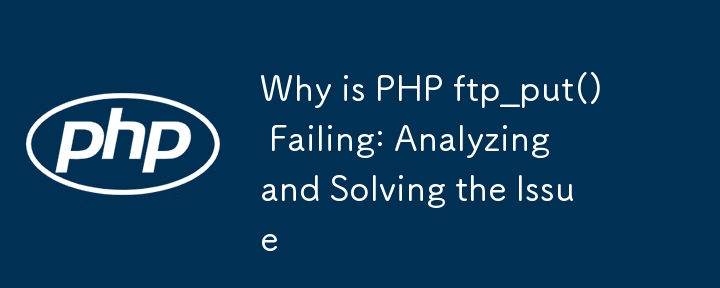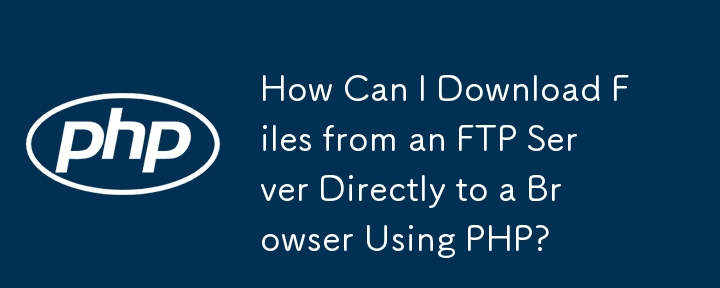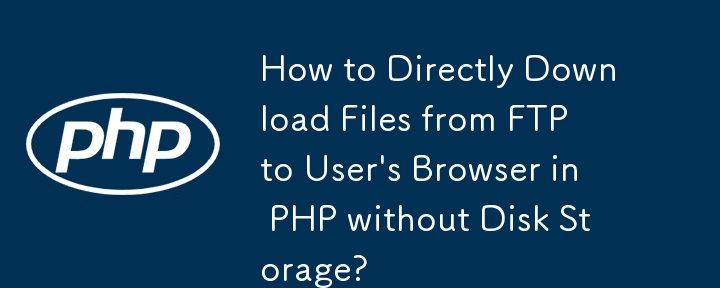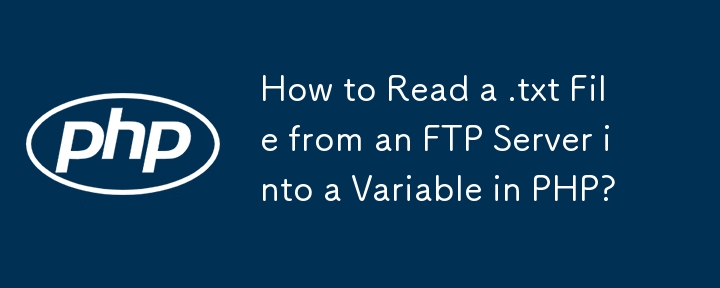Found a total of 10000 related content

PHP tutorial on creating and uploading new files through FTP
Article Introduction:This tutorial details how to create and upload new files on a remote server using PHP via the FTP protocol. The article covers key steps such as FTP connection establishment, login verification, file upload and connection closing, and provides sample code to help developers quickly master the implementation methods of PHP FTP file upload while avoiding common upload failure problems.
2025-08-24
comment 0
809

How do you Retrieve FTP Files into PHP Variables?
Article Introduction:FTP File Retrieval into PHP Variable: A Detailed GuideWhen working with remote files, it's often necessary to read their contents into variables...
2024-10-26
comment 0
570

How Can I Implement an SFTP Client in PHP?
Article Introduction:PHP SFTP Client Implementation: A Comprehensive GuideMany programs exist for PHP clients for FTP web access. However, the need may arise to...
2024-11-28
comment 0
1190

Why is PHP ftp_put() Failing: Analyzing and Solving the Issue
Article Introduction:FTP file transfer issues with ftp_put() in PHP can often be attributed to the default use of active mode. To resolve this, switching to passive mode using ftp_pasv() is recommended. Additionally, if the FTP server reports an incorrect IP address, dis
2024-10-24
comment 0
523

How to Deploy a PHP 7 Application to a Web Server?
Article Introduction:This article details deploying PHP 7 applications, covering methods (FTP, SSH, deployment tools), server configuration (Apache/Nginx, PHP-FPM), database setup, and crucial security considerations. It highlights common challenges like server compatib
2025-03-10
comment 0
662

How to Troubleshoot Failed FTP Uploads Using PHP ftp_put?
Article Introduction:FTP uploads using ftp_put may fail due to active mode FTP. To resolve this, switch to passive mode using ftp_pasv. For servers reporting incorrect IP addresses, disable FTP_USEPASVADDRESS. By using these techniques, FTP upload failures can be address
2024-10-23
comment 0
796

Tutorial on creating and uploading new files via FTP using PHP
Article Introduction:This tutorial introduces in detail how to use PHP's FTP extension to create and upload files through the ftp_put() function. The content covers key steps such as FTP connection establishment, user login, passive mode configuration, file transfer mode selection, and error handling, and provides complete sample code and best practices to help developers efficiently and securely upload local files to remote FTP servers.
2025-08-25
comment 0
211

How to install WordPress manually
Article Introduction:Installing WordPress mainly includes the following steps: 1. Prepare the host, FTP login information and FTP client that supports PHP and MySQL; 2. Download and unzip the program package from wordpress.org to ensure that the wp-config-sample.php file is included; 3. Create a database in the host control panel, and create a configuration file wp-config.php with wp-config-sample.php to fill in the correct database information; 4. Use FTP or file manager to upload all WordPress files to the website root directory; 5. Access the domain name in the browser and enter the installation wizard, fill in the site title and administrator account information to complete the installation; 6. Install
2025-07-30
comment 0
932


How to enable WP_DEBUG mode
Article Introduction:To enable WordPress's WP_DEBUG mode, you need to edit the wp-config.php file. 1. Log in to the host background or use FTP to find and download wp-config.php; 2. Open and back up the original file with a text editor; 3. Add define('WP_DEBUG',true); optionally add define('WP_DEBUG_DISPLAY',false); and define('WP_DEBUG_LOG',true); and upload the file after saving. WP_DEBUG is a debugging tool for WordPress, used to display PHP error messages, only for development environment use, production environment should be related.
2025-07-19
comment 0
767

Deploying a Laravel Application.
Article Introduction:When deploying Laravel applications, you need to pay attention to environment configuration, code upload, database settings and task configuration. 1. Prepare the server environment, install PHP (8.0), Composer, Nginx/Apache and MySQL/MariaDB, and configure necessary extensions and services; 2. Upload the project and install dependencies, use FTP or Git to upload code, run composerinstall and generate optimization commands; 3. Configure database information, create database and set permissions, perform migration and seeder, adjust storage/and bootstrap/cache/ permissions; 4. If you use queue or timing tasks, start worker or add Cron entries to
2025-07-21
comment 0
168

How to scan WordPress for malware
Article Introduction:To scan WordPress websites for malware, you can follow the following steps: 1. Use security plug-ins (such as Wordfence, iThemesSecurity, or Sucuri) to scan the entire site to view suspicious files or accounts; 2. Check suspicious code in themes and plug-ins, especially base64 encoded or recently modified files; 3. Check abnormal files on the server through FTP, such as .php files in the uploads directory or suspicious files in the root directory; 4. Use phpMyAdmin to check whether there are malicious scripts, exception URLs or unknown administrator accounts in the database. When abnormalities are found, backup should be done first and then processed, and these checks should be performed regularly to ensure the security of the website.
2025-07-17
comment 0
805



















